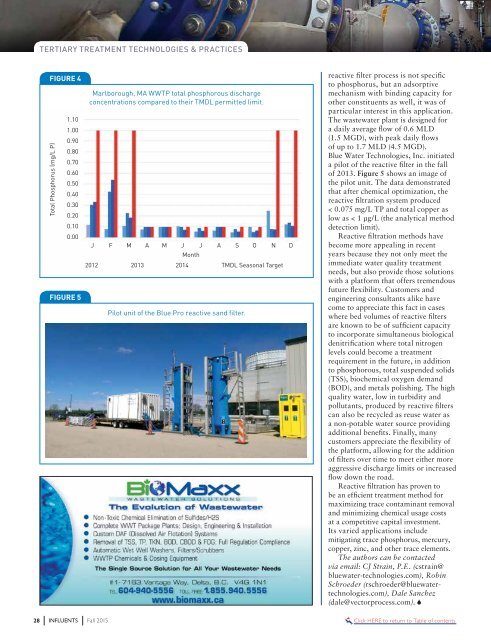lauren@kelman.ca
1YLWYxL
1YLWYxL
Create successful ePaper yourself
Turn your PDF publications into a flip-book with our unique Google optimized e-Paper software.
TERTIARY TREATMENT TECHNOLOGIES & PRACTICES<br />
FIGURE 4<br />
1.10<br />
1.00<br />
Total Phosphorus (mg/L P)<br />
0.90<br />
0.80<br />
0.70<br />
0.60<br />
0.50<br />
0.40<br />
0.30<br />
0.20<br />
0.10<br />
0.00<br />
FIGURE 5<br />
Marlborough, MA WWTP total phosphorous discharge<br />
concentrations compared to their TMDL permitted limit.<br />
J F M A M J J A S O N D<br />
Month<br />
2012 2013 2014 TMDL Seasonal Target<br />
Pilot unit of the Blue Pro reactive sand filter.<br />
reactive filter process is not specific<br />
to phosphorus, but an adsorptive<br />
mechanism with binding <strong>ca</strong>pacity for<br />
other constituents as well, it was of<br />
particular interest in this appli<strong>ca</strong>tion.<br />
The wastewater plant is designed for<br />
a daily average flow of 0.6 MLD<br />
(1.5 MGD), with peak daily flows<br />
of up to 1.7 MLD (4.5 MGD).<br />
Blue Water Technologies, Inc. initiated<br />
a pilot of the reactive filter in the fall<br />
of 2013. Figure 5 shows an image of<br />
the pilot unit. The data demonstrated<br />
that after chemi<strong>ca</strong>l optimization, the<br />
reactive filtration system produced<br />
< 0.075 mg/L TP and total copper as<br />
low as < 1 µg/L (the analyti<strong>ca</strong>l method<br />
detection limit).<br />
Reactive filtration methods have<br />
become more appealing in recent<br />
years be<strong>ca</strong>use they not only meet the<br />
immediate water quality treatment<br />
needs, but also provide those solutions<br />
with a platform that offers tremendous<br />
future flexibility. Customers and<br />
engineering consultants alike have<br />
come to appreciate this fact in <strong>ca</strong>ses<br />
where bed volumes of reactive filters<br />
are known to be of sufficient <strong>ca</strong>pacity<br />
to incorporate simultaneous biologi<strong>ca</strong>l<br />
denitrifi<strong>ca</strong>tion where total nitrogen<br />
levels could become a treatment<br />
requirement in the future, in addition<br />
to phosphorous, total suspended solids<br />
(TSS), biochemi<strong>ca</strong>l oxygen demand<br />
(BOD), and metals polishing. The high<br />
quality water, low in turbidity and<br />
pollutants, produced by reactive filters<br />
<strong>ca</strong>n also be recycled as reuse water as<br />
a non-potable water source providing<br />
additional benefits. Finally, many<br />
customers appreciate the flexibility of<br />
the platform, allowing for the addition<br />
of filters over time to meet either more<br />
aggressive discharge limits or increased<br />
flow down the road.<br />
Reactive filtration has proven to<br />
be an efficient treatment method for<br />
maximizing trace contaminant removal<br />
and minimizing chemi<strong>ca</strong>l usage costs<br />
at a competitive <strong>ca</strong>pital investment.<br />
Its varied appli<strong>ca</strong>tions include<br />
mitigating trace phosphorus, mercury,<br />
copper, zinc, and other trace elements.<br />
The authors <strong>ca</strong>n be contacted<br />
via email: CJ Strain, P.E. (cstrain@<br />
bluewater-technologies.com), Robin<br />
Schroeder (rschroeder@bluewatertechnologies.com),<br />
Dale Sanchez<br />
(dale@vectorprocess.com).<br />
28 INFLUENTS Fall 2015<br />
Click HERE to return to Table of contents


